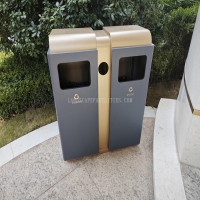Welcome to the website for landscape facilities products and knowledge.
How does the shape of the trash can impact its ease of cleaning and sanitation?
The shape of a trash can plays a crucial role in determining how easy it is to clean and maintain proper sanitation. A well-designed trash bin not only enhances functionality but also ensures hygiene, reducing the risk of bacterial growth and unpleasant odors.
1. Smooth, Rounded Designs
Trash cans with smooth, rounded interiors are easier to clean because they lack sharp corners where debris and grime can accumulate. These designs allow for quick wiping or rinsing, minimizing the effort required to maintain cleanliness.
2. Square or Rectangular Bins
While square or rectangular trash cans may offer more storage space, their corners often trap waste particles, making them harder to sanitize thoroughly. Regular deep cleaning is necessary to prevent residue buildup.
3. Open vs. Covered Designs
Open-top trash cans are simpler to clean but may expose waste to pests and odors. Covered bins, especially those with pedal-operated lids, improve sanitation by containing messes, though their hinges and crevices may require extra attention during cleaning.
4. Material Considerations
The shape’s impact also depends on the material. Stainless steel or plastic bins with seamless designs are more hygienic, while textured or ribbed surfaces can harbor bacteria if not cleaned properly.
5. Practical Tips for Maintenance
- Opt for trash cans with removable liners or inner buckets for effortless cleaning.
- Choose shapes that align with your cleaning tools (e.g., flat surfaces for wipes).
- Regularly disinfect high-touch areas like lids and handles.
By selecting a trash can with a thoughtful shape and design, you can significantly improve cleaning efficiency and long-term sanitation. Prioritize simplicity and accessibility to ensure a healthier environment.
Related search:

Recommendation
Double-bucket garbage bin, outdoor, metal, multi-color, powder-coated, double-bucket trash can